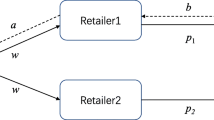Abstract
This paper studies the consignment contract with revenue sharing where the retailer offers two revenue share schemes between himself and his supplier from the viewpoint of inventory ownership: One is that the retailer takes charge of the unsold items, the other one is that the retailer returns the unsold items to the supplier at the end of the selling period, and the supplier disposes those overstockings. In each contract, the retailer deducts a percentage from the selling price for each sold item and transfers the balance to the supplier. The supplier solves a two-stage problem: She first chooses contract, then decides retail price and delivery quantity according to the terms of the contract chosen. With an iso-price-elastic demand model, the authors derive the retailer and suppliers’ optimal decisions for both schemes. In addition, the authors characterize how they are affected by disposing cost. The authors compare the decisions between the two schemes for disposing cost turn out to be holding cost or salvage value, respectively. The authors use numerical examples to show the supplier’s first-stage optimal decision depends critically on demand price elasticity, the disposing cost and the retailer’s share for channel cost.
Similar content being viewed by others
References
W. H. Bolen, Contemporary Retailing, Prentice-Hall, Englewood Cliffs, NJ, 1978.
Y. Wang, L. Jiang, and Z. Shen, Channel performance under consignment contract with revenue sharing, Management Science, 2004, 50(1): 34–47.
S. Karlin and C. R. Carr, Prices and optimal inventory policy, K. J. Arrow, S. Karlin, H. Scarf, eds., Studies in Applied Probability and Management Science, Stanford University Press, Stanford, CA, 1962.
N. Petruzzi and M. Dada, Pricing and the newsvendor problem: A review with extensions, Operation Research, 1999, 47: 184–194.
G. P. Cachon and M. A. Lariviere, Supply chain coordination with revenue-sharing contracts: Strengths and limitations, Management Science, 2005, 51(1): 30–44.
S. C. Choi, Price competition in a channel structure with a common retailer, Marketing Science, 1991, 10(4): 271–296.
H. Emmons and S. Gilbert, The role of returns policies in pricing and inventory decisions for catalogue goods, Management Science, 1998, 44(6): 276–283.
A. Ha, supplier-buyer contracting: Asymmetric cost information and the cut-off level policy for buyer participation, Naval Research Logistics, 2001, 48: 41–46.
S. C. Hackett, Consignment contracting, Journal of Economic Behavior and Organization, 1993, 20(2): 247–253.
Y. Wang, Joint pricing-production decisions in supply chains of complementary products with uncertain demand, Operation Research, 2006, 54: 1110–1127.
Author information
Authors and Affiliations
Corresponding author
Additional information
This research was supported by the National Natural Science Foundation of China under Grant Nos. 70901029, 71171088, 71131004, and 71002077, and the Fundamental Research Funds for the Universities under Grant No. 65010771.
This paper was recommended for publication by Editor Shouyang WANG.
Rights and permissions
About this article
Cite this article
Hu, W., Li, J. Disposing the leftovers under the consignment contract with revenue sharing: Retailer vs supplier. J Syst Sci Complex 25, 262–274 (2012). https://doi.org/10.1007/s11424-011-9063-7
Received:
Revised:
Published:
Issue Date:
DOI: https://doi.org/10.1007/s11424-011-9063-7




